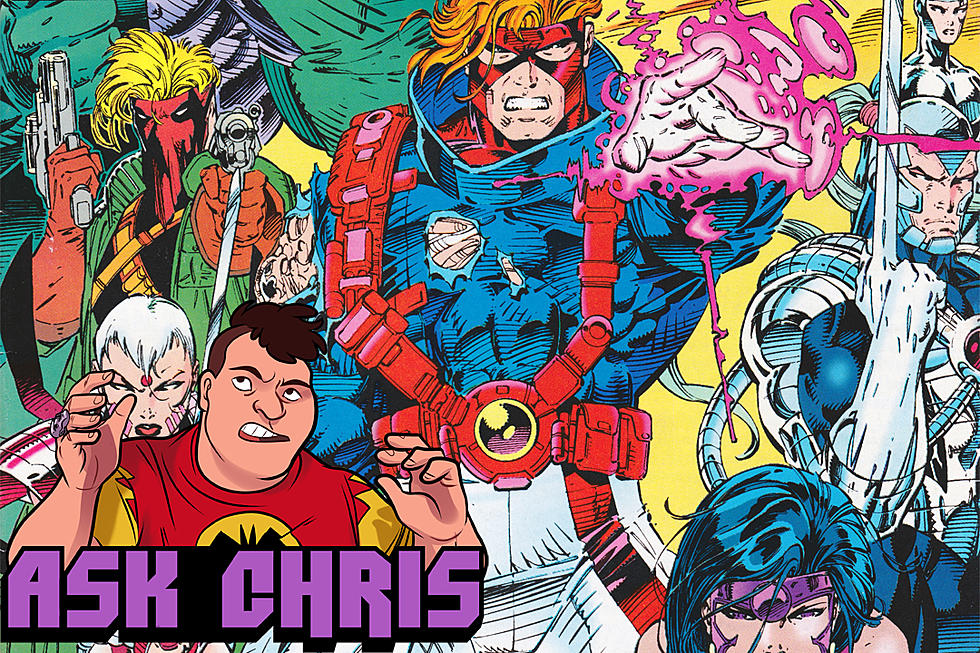
Wildcats 3.0: A Look Back at a Comic Too Far Ahead of Its Time
 The role of corporations in comics has taken a fascinating turn over the last few years. It used to be that corporations were the go-to adversary: shadowy mechanisms with bad intentions, ruled by greed and bureaucracy, with nearly limitless resources and capacity for mayhem. It seemed as though everywhere a hero went, there was a villainous board of stockholders trying to take him or her down. In the Silver Age, Lex Luthor was a mad scientist; in the eighties, a businessman. But things have changed.
The role of corporations in comics has taken a fascinating turn over the last few years. It used to be that corporations were the go-to adversary: shadowy mechanisms with bad intentions, ruled by greed and bureaucracy, with nearly limitless resources and capacity for mayhem. It seemed as though everywhere a hero went, there was a villainous board of stockholders trying to take him or her down. In the Silver Age, Lex Luthor was a mad scientist; in the eighties, a businessman. But things have changed.
In top-tier titles like Batman, Inc.,Invincible Iron Man, and Fantastic Four, the benevolent business entity has been getting a lot of playing time, and it feels like a growing trend. However, the best example of this idea of the altruistic corporation-as-superhero was published back in the hazy days of the early 2000s, and it still feels like the rest of them are trying to catch up.
Yes. Wildcats Version 3.0. Way to read a title. And with a new edition of 3.0 Year Two hitting stands again, there's never been a better opportunity to look back at the book that was too far ahead of its time.
Writer Joe Casey has always seemed like something of an unrecognized icon. Though he's enjoyed some acclaimed runs on high-profile titles like Uncanny X-Men and Adventures of Superman, and the creator-owned Godland with Tom Scioli, nothing has really topped the sales charts. And despite the fact that he's been working in the industry over ten years, his resume seems a little light when compared with other veterans. Granted, that may have something to do with being part of Man of Action (along with Joe Kelly, Duncan Rouleau, and Steven Seagle), the group that created Ben 10, and probably having his own Scrooge McDuck-like money bin filled with gold and the bones of comics bloggers. But even before Ben 10, Casey was not the type to take a project just for the money, so it's not a surprise that his oeuvre isn't quite as large as those of his contemporaries.
But it ain't the size of the ship, folks. Though he may not quite have the name recognition or cache' of Ed Brubaker or Brian K. Vaughan, there's no mistaking the intelligence and originality Casey brings to his projects. (Remember Automatic Kafka? Of course you don't, you didn't buy it, did you, jackface?) And there is no better evidence of his brilliance than Wildcats Version 3.0.

After assuming the reins from Scott Lobdell, Travis Charest and others on WildCats Volume 2, Casey and artist Sean Phillips did some serious housecleaning. The template established by Jim Lee and Brandon Choi, and refined by Alan Moore, got blown up, eviscerated, repeatedly shot in the face, and had an a**load of sugar poured in its gas tank. Volume 2 ended at 28 in 2001, and in late 2002, 3.0 landed like a hit single: a true pop art imagining of the corporation-as-superhero that was immediately one of the smartest and best-looking comics on the stands.
So of course it didn't sell great. Not well enough to get past issue 24, anyway. (P.S. this is why bloggers act like we have better taste than you: because we do. So, following that logic, if there were more bloggers, unconventional wonders like 3.0 would be outselling whatever it is that sells the most. I'm in no mood for research.) But for two full years, erudite readers/awesome bloggers were treated to real genre-stretching brilliance.
The story was both very simple and highly unconventional. As CEO of Halo Corp, Spartan's mission was very clear-cut: make the world a better place. How? Batteries. Utilizing Void's access to Otherspace, a sort of higher dimension of limitless energy sources, Halo manufactures ever-lasting batteries - infinite power supplies sold at affordable prices. Under Spartan's leadership, Halo grows exponentially, vertically integrating all aspects of the business under one umbrella, acquiring media and manufacturing, and making businesses and governments very nervous.
 Despite his claims that Halo is an altruistic enterprise, even his closest associates question his motives. Can a privately-owned corporation truly be interested in the betterment of the world? Casey plays on preconceptions of big business in some very clever ways, always keeping that kernel of doubt somewhere in the back of the reader's mind. The idea to manufacture batteries that last forever actually comes from Noir, a weapons genius villain who betrayed the team and tried to take over the company in Volume 2. Spartan values ideas above all else, and despite Noir's intent, Spartan recognizes that he had a point: "if you're going to take over the world, this is the way to do it." He adopts Noir's idea and sets out to make the world a better place through advanced technology and brand-building: "I'm going to turn Halo into the biggest brand name in the world. A juggernaut that will transform the face of consumer culture..."
Despite his claims that Halo is an altruistic enterprise, even his closest associates question his motives. Can a privately-owned corporation truly be interested in the betterment of the world? Casey plays on preconceptions of big business in some very clever ways, always keeping that kernel of doubt somewhere in the back of the reader's mind. The idea to manufacture batteries that last forever actually comes from Noir, a weapons genius villain who betrayed the team and tried to take over the company in Volume 2. Spartan values ideas above all else, and despite Noir's intent, Spartan recognizes that he had a point: "if you're going to take over the world, this is the way to do it." He adopts Noir's idea and sets out to make the world a better place through advanced technology and brand-building: "I'm going to turn Halo into the biggest brand name in the world. A juggernaut that will transform the face of consumer culture..."
The brand-building idea not only made Wildcats one of the most intellectually stimulating books on the market, it provided an excuse for the artists to riff conceptually, making it one of the most visually stimulating. Dustin Nguyen and Rian Hughes's covers flaunted ad design and package presentation with a final product that was usually a cover and a commercial at once. Nguyen produced the majority of the interiors for the series, and he grew at a substantial rate, but his most important work was done on covers and title/credits pages.
All in all, it was a very unique book, and one that never got the readership it deserved. It might not have helped that it was a Mature Readers title, either. Commercially, anyway. Artistically, it totally helped. Casey's sense of humor comes through untethered, and every other characterization of Cole Cash as Grifter is ****** in the **** with a screwdriver. Pure hell and mayhem was unleashed in every issue, with inventive action that did nothing to shy away from the consequences of violence. Grown up words and pictures to go with a grown up concept.
Great business is about adaptability, and in Wildcats Version 3.0 that's the ultimate concern. Halo is adapted into a new model of altruistic corporation. The primary characters are faced with dilemmas that require fluidity and compromise -- Cash deals with life in a wheelchair, Agent Wax embroils himself in some very ambiguous morality, Edwin Dolby is thrown into some very deep, scary waters at Halo, and forced to adapt. Even "Ladytron," Maxine Manchester has adapted: her consciousness downloaded to the Halo database, her likeness living on as advertising.
So could the superhero genre comic really be adapted to the twenty-first century?
Yes. Just a few years too soon.

More From ComicsAlliance
![All The Image Comics Announcements From Emerald City Comic Con [ECCC ’17]](http://townsquare.media/site/622/files/2017/03/Image-Featured.png?w=980&q=75)








